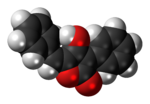Pulvinic acids are natural chemical pigments found in some lichens, derived biosynthetically from the aromatic amino acids phenylalanine and tyrosine,...
4 KB (329 words) - 01:25, 7 January 2024
pulvinic acid-type family, himanimides, and polyine acids. Within the pulvinic acid-type family, atromentin-derived compounds include variegatic acid...
12 KB (1,110 words) - 23:50, 1 July 2024
acid methyl ester 3-O-Methylvariegatic acid methyl ester 3,3',4,4'-Tetra-O-methyl variegatic acid methyl ester Pulvinic acid Pulvinone Vulpinic acid Velíšek...
6 KB (555 words) - 02:26, 27 December 2023
derivative of its parent compound, pulvinic acid, and a close relative of pulvinone, both of which derive from aromatic amino acids such as phenylalanine via secondary...
10 KB (856 words) - 10:21, 31 October 2023
including the orange variegatic acid, methyl variegate, the red variegatorubin, and several derivatives of pulvinic acid. The presence of these pigments...
35 KB (3,317 words) - 02:53, 14 May 2024
as ascorbic acid (vitamin C), penicillic acid, pulvinic acids, and abyssomicins possess the β-keto-γ-butyrolactone motif of tetronic acid. In organic...
3 KB (221 words) - 16:45, 30 June 2022
genetic and enzymatic basis for atromentin, the precursor to various pulvinic acid-type pigments, has been characterized (an atromentin synthetase by the...
7 KB (633 words) - 10:23, 19 May 2024
lichen products, including calycin, leprapinic acid, vulpinic acid, zeorin, and trace amounts of pulvinic acid and unidentified terpenoids. These chemical...
25 KB (2,325 words) - 20:20, 1 March 2024
Onose J, Abe N, Yoshikawa K (2009). "In vitro inhibitory effects of pulvinic acid derivatives isolated from Chinese edible mushrooms, Boletus calopus...
5 KB (510 words) - 05:36, 10 January 2024
characterized by the presence of pigments based on the chemical structure of pulvinic acid, a yellow-orange compound found in some species of Boletales. The pigments...
15 KB (1,551 words) - 16:15, 10 January 2024
high-performance liquid chromatography) include calycin, pulvic acid lactone, vulpinic acid, and pulvinic acid. Westberg, Martin (2007). "Candelariella (Candelariaceae)...
3 KB (215 words) - 01:20, 13 October 2022
causing severe sickness in Europe. The pulvinic acid derivatives atromentic acid, variegatic acid, and xerocomic acid are present in B. calopus mushrooms...
28 KB (2,720 words) - 05:21, 17 July 2024
Variegatorubin is a pulvinic acid derivative. It is a red pigment that is present in many members of the Boletales, an order of the division Basidiomycota...
3 KB (146 words) - 06:05, 29 January 2023
presence of the secondary metabolites pulvinic acid and vulpinic acid, compounds that when combined with usnic acid, give the species their characteristic...
10 KB (969 words) - 19:09, 17 October 2023
oxidized form of isoxerocomic acid. Air oxidation is responsible its formation, and it oxidizes faster to a similar pulvinic acid type pigment oxidized variant...
2 KB (214 words) - 14:38, 5 March 2024
in the type species, including variegatic acid, variegatorubin, and several other derivatives of pulvinic acid, suggests a chemotaxic relationship with...
29 KB (2,197 words) - 06:32, 15 August 2024
air, as a result of the oxidation of pulvinic acid derivatives, like variegatic, xerocomic, and atrotomentinic acids. Boletaceae were first described by...
48 KB (4,111 words) - 21:39, 21 June 2024
that was once considered unique to this genus. Some species contain pulvinic acid-related pigments; in these species the soredia and pseudocyphellae can...
15 KB (1,447 words) - 08:44, 8 November 2023
Bebert discovered a compound named vulpinic acid, the first known naturally occurring methyl ester of pulvinic acid. More details about the structure of this...
15 KB (1,581 words) - 16:57, 20 December 2023
high-performance liquid chromatography) include calycin, pulvic acid lactone, vulpinic acid, and pulvinic acid. Westberg, Martin (2007). "Candelariella (Candelariaceae)...
2 KB (206 words) - 20:52, 12 September 2022
typically breaks and eventually dissolves into soredia. Calycin and pulvinic acid are the major secondary metabolites present in the lichen. Liu, Dong;...
2 KB (143 words) - 01:11, 3 November 2023
are K+ reddish, KC−, and C−. It produces calycin, pulvinic acid, pulvinic dilactone and vulpinic acid as secondary metabolites. Candelariella vitellina...
4 KB (382 words) - 17:08, 24 October 2023
pigments, including the pulvinic acids such as variegatic acid, xerocomic acid, homoxerocomic acid, isoxerocomic acid, atromentic acid, variegatorubin, xerocomorubin...
15 KB (1,525 words) - 20:24, 7 July 2024
reddish-brown proper exciple. Usnic acid and isousnic acid are lichen products found in the species; it does not contain pulvinic acid derivatives, which contrasts...
5 KB (393 words) - 18:40, 12 July 2024
products are found in the genus, including calicin, pulvinic acid, pulvinic dilactone, and vulpinic acid. The genus Candelinella includes two identified species:...
8 KB (593 words) - 14:49, 5 January 2024
by 2.0–2.5 μm. The stalk and the head of the apothecium both contain pulvinic acid, a lichen product. Aptroot, André; Mota Junior, Narla; Santos, Viviane...
2 KB (211 words) - 20:43, 16 April 2024
present in Candelaria asiatica are calycin acid, a UV filter or UVA screening compound, and pulvinic acid, a natural chemical pigment. Candelaria (lichen)...
5 KB (659 words) - 01:14, 24 May 2024
unique chemical substances it contains, such as calycin, pulvinic and vulpinic acids, and pulvinic acid lactone. The genus Opeltiella was circumscribed by Ukrainian...
7 KB (567 words) - 09:03, 5 January 2024
depsidones, aliphatic acids, triterpenes, anthraquinones, secalonic acids, pulvinic acid derivatives, and xanthones. The compounds usnic acid and atranorin,...
38 KB (3,126 words) - 20:30, 1 June 2024
grevillei var. badius, and becomes the pigment thelephoric acid. Pulvinic acid Pulvinone Vulpinic acid Yannai, Shmuel (2003). Dictionary of Food Compounds with...
2 KB (148 words) - 14:51, 19 August 2022






















